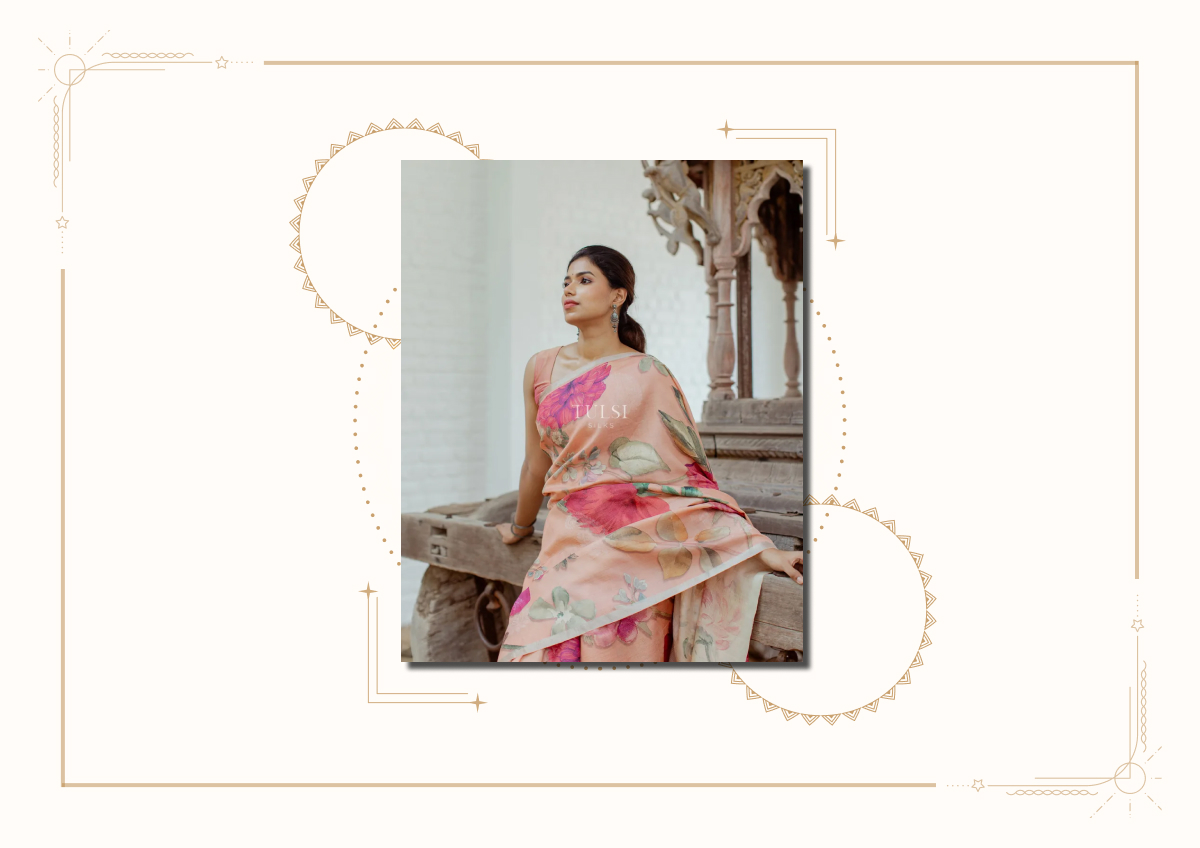Learn History of Saree, Evolution of Sarees & About Sarees in Detail
Sarees with their popularity in fashion now are loved by the masses for their adaptable nature and elite visuals however, their beginnings were humble as it was considered an out-and-out traditional garment rather than modern and contemporary.
Their cultural and historical significance along with their never-ending charm that evolves over time is something that leaves us women baffled. Isn’t it? In this blog, we will be delving deep into the history of sarees, the evolution of sarees in India and their significance in Indian culture to understand the ins and outs of this ethereal-looking garment. So go ahead and give this blog a good read!
Want to buy sarees in Chennai or online that look enchanting and sophisticated while offering an extreme level of comfort and quality? Then head over to Tulsi Silks’ store in Mylapore or shop online from our extensive collection suitable for every taste and event.
About Saree
What is a saree? What makes them so unique, charming and exceptionally graceful?
Well, sarees are a popular and highly celebrated garment for women that comes in a variety of colours, designs, prints and patterns with each offering a distinct look and appeal.
“Elegant, sophisticated and enchanting” is what we believe to be the perfect saree description.
The word saree originated from the Sanskrit word “Saadi” which loosely translates to “a strip of cloth”. In Sanskrit literature, the word saree is usually described as sattika meaning “women’s attire” and in Buddhist literature it is jatakas. Just like the colour, design and fabric, the saree length will also vary from saree to saree as some could be under the length of 6 yards whereas some could go up to 9 yards and are called madisar.
Having a knack for fitting all event types and occasions, sarees are perfect for everything from weddings, engagements, and receptions to parties and formal meet-ups. There is probably no event where you can’t manage to style a saree to suit the theme of the said event. Read further about sarees to understand their significance and history.
History of Saree
The history of sarees can be traced back to the Indus Valley Civilisation where weavers used dyes such as indigo, lac, red madder and turmeric to create the garment and beautify it further. Mughals during the 16th and 19th centuries, known for their love for lavishness and opulent clothing, refined the look of the saree by embellishing it with elaborate embroidery such as zardozi and kamdani as well as other grand designs. The saree later became a regular and everyday wear during the Mughal era which was widely worn both by the royalties in the palace and the commoners.
A lesser-known fact about sarees is that they were worn both by men and women during ancient times and were considered gender-neutral garments, unlike today’s era. However, over time sarees started to gain more popularity as women’s clothing for their feminine and soft looks and became a women’s clothing.
The true Indian saree history tells us that women in the older times did not wear any blouse and they only came into existence after the introduction of the blouses for sarees by the British Raj during the Victorian era where flaunting one’s arms and shoulders were considered inappropriate and improper. Soon this idea of wearing blouses for sarees spread over across the country and became a common phenomenon among women.
Wondering where can you buy sarees that offer comfort, beauty and quality - all in one? Read our blog on the silk saree shops & famous places to buy silk sarees for weddings in Chennai.
Evolution of Saree
Learning about the saree origin is fun but so is knowing about the impressive evolution of sarees with its twists and turns over a while.
A significant evolution of sarees in India in the history of saree is when the British Raj imposed the idea of wearing blouses and also introduced new fabrics such as Chiffon, net and georgette for breathability and comfort in humid and hot weather.
Another notable history and evolution of sarees is the implementation of newer techniques of dyeing and printing which paved the way for designers to experiment with different styles, designs, patterns and prints. Saree designs such as temple motifs, floral prints and nature-inspired designs became quite a rage among women from all strata at that time.
This remarkable evolution of the saree opened a new horizon for much more experimentation and innovation which later transformed into women trying new draping styles such as the nivi saree draping and many other ways of styling a saree that took over the fashion scene.
Now in this modern fashion era, sarees have evolved beyond comprehension with their unconventional and contemporary style and charm infused by fashion designers to keep up with the trends and the ever-changing preferences of saree wearers. It wouldn’t be wrong to say that sarees are now a must-have in every woman’s wardrobe whether her style reflects traditionality or modernity.
Significance of Saree in Indian Culture
The saree holds a deep cultural and historical significance in India, symbolising grace, elegance, and tradition. This timeless garment, worn by women across the country, is not just an attire but a representation of Indian heritage. The intricate weaving techniques, diverse saree material, and regional variations highlight the rich textile traditions of India.
Each saree, from the Banarasi to the Kanjivaram, tells a story of the place it originates from, reflecting local artistry and craftsmanship. Wearing a saree during festivals, weddings, and significant ceremonies underscores its importance in marking special occasions and preserving cultural identity.
Also Read: How You Can Shop for Sarees Online Safely?
Different Saree Draping Styles
Just like the evolution of sarees in India in terms of designs, printing and dyeing techniques, the draping and styling of sarees has also evolved over the past years. Draping styles from different origins such as Coorgi style saree draping from Karnataka and Nauvari style saree wearing from Maharashtra are some of the most iconic draping styles in recent years. We have listed the different saree draping styles that as a woman you must know in 2024:
1. Nivi Style
2. Bengali Style
3. Dhoti Style Draping
4. Lehenga Style Draping
5. Butterfly Draping
6. Corgi Style
7. Nauvari Style Draping
8. Belted Saree Draping
9. Gujarati Saree Draping
10. Mermaid Style Saree Draping
Also Read: 15 Latest Different Types of Modern & Traditional Saree Wearing & Draping Styles for Weddings & Parties.
List of Saree Names That Are Popular
The saree materials and fabrics that exude grace, femininity and class are limitless. Each and every saree type has unique characteristics and features that radiate beauty and sophistication that are unmatched. Below we have a list of saree names that are popular in 2024 among women:
- Banarasi Saree
- Kanjivaram Saree
- Chanderi Saree
- Patola Saree
- Paithani Saree
- Bandhani Saree
- Pochampally Saree
- Gadwal Saree
- Silk Sarees
- Georgette Sarees
- Organza Sarees
- Cotton Sarees
- Linen Sarees
- Chiffon Sarees
- Kota Sarees
- Baluchari Sarees
- Mysore Silk Sarees
- Tussar Sarees
These saree names are celebrated for their unique saree material, craftsmanship, and regional charm, making them cherished pieces in every Indian woman’s wardrobe.
Sarees are beautiful and exude charm regardless of who wears them and when it is worn. So what’s stopping you from buying one and creating a stunning saree look for yourself? Shop the best sarees at Tulsi Silks online or at our offline store located in Mylapore offering a range of different saree materials, styles and types perfect for all events and preferences.
If you are a fashion lover, then check out our other blogs on various topics including sarees, trends in fashion, history and much more.




